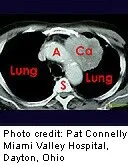Yearly tests picked up malignant tumors sooner than X-rays, study found
WebMD News from HealthDay

By Dennis Thompson
HealthDay Reporter
WEDNESDAY, Sept. 4 (HealthDay News) -- Annual lung cancer screenings using low-dose CT scans can successfully detect malignant tumors before they can spread to other parts of the body, according to two new studies.
Yearly screenings with CT scans are more effective than regular chest X-rays in finding early stage cancers, according to a U.S. study that is part of the federally funded National Lung Screening Trial.
CT scans caught more early stage lung cancers than chest X-rays did during annual screenings over three years, the research team reported. What's more, the ability to accurately detect cancer improved year to year.
"When we're screening once a year every year we are finding early stage lung cancers that are potentially curable," said Dr. Caroline Chiles, a professor of radiology in the Comprehensive Cancer Center of Wake Forest Baptist Medical Center and a principal investigator for the national lung screening study. "We really start seeing benefit when someone stays in annual screening."
The findings appear in the Sept. 5 issue of the New England Journal of Medicine, along with another related study.
Canadian researchers have developed an effective method for sorting potentially dangerous tumors from benign nodules detected during a CT lung screening, the second study reports.
Their checklist takes into account the size, shape and location of detected nodules, as well as other risk factors such as smoking or family history, said lead author Dr. Stephen Lam, chair of the Provincial Lung Tumor Group and director of the MDS-Rix Early Lung Cancer Detection and Translational Research Program at the British Columbia Cancer Agency.
"Our nodule predictor has an accuracy of over 90 percent in determining whether a nodule needs to be followed up to rule out a cancerous lesion," Lam said.
Doctors using the checklist can prevent people from receiving unnecessary follow-up CT scans or biopsies, reducing their radiation exposure or surgical risk, said Lam, who is also a professor of medicine at the University of British Columbia.
These studies appear as U.S. officials are weighing whether to green-light annual CT scans as a preventive health measure for a specifically defined set of heavy smokers.
The U.S. Preventive Services Task Force -- an independent volunteer panel of national health experts -- has recommended regular low-dose screenings for current and former smokers aged 55 to 80 with at least a 30 "pack-year" history of smoking who have had a cigarette sometime within the last 15 years.
Pack years are determined by multiplying the number of packs smoked daily by the number of years a person has smoked. For example, a person who has smoked two packs a day for 15 years has 30 pack years, as has a person who has smoked a pack a day for 30 years.
source : More Evidence Backs Routine CT Scans for Early Lung Cancer Detection








